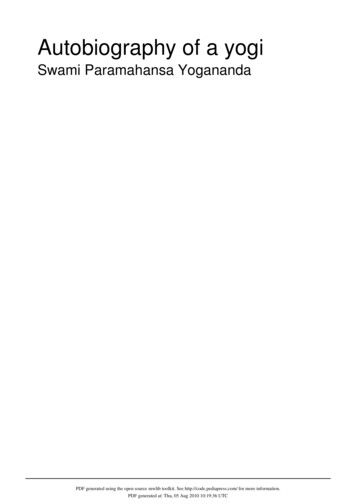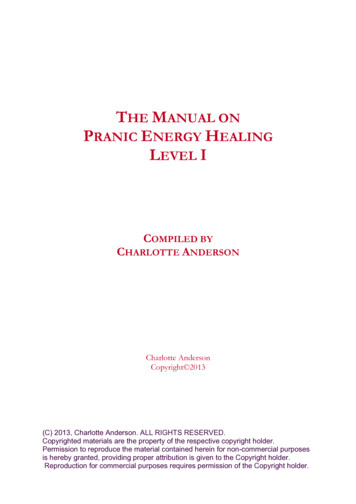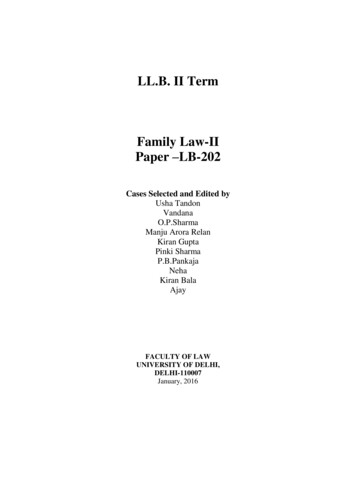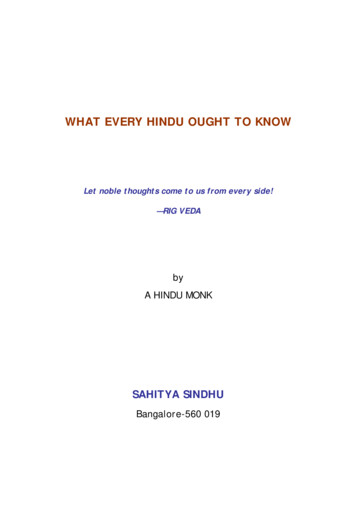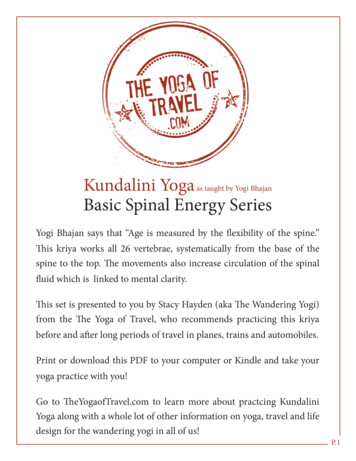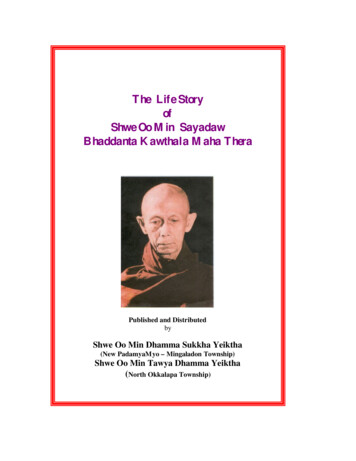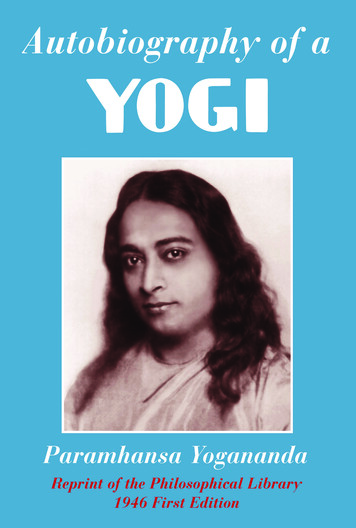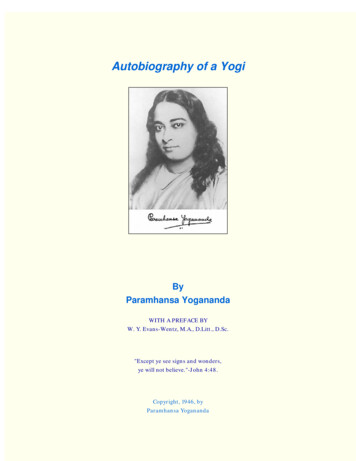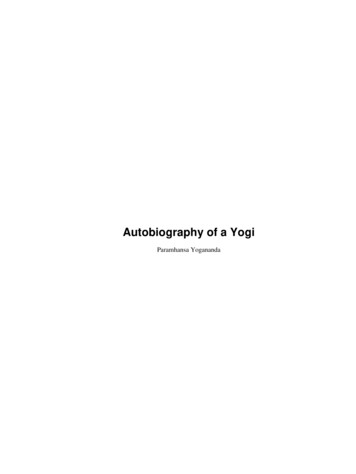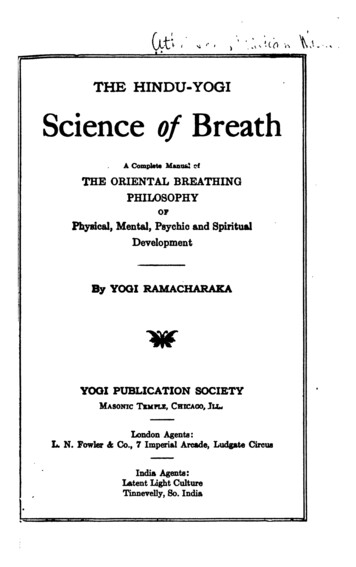
Transcription
)' toTHE HINDU-YOGIScience o f BreathA Complete Manus! efTHE ORIENTAL BREATHINGPHILOSOPHYOFPhysical, Mental, Psychic and SpiritualDevelopmentBy YOGI RAMACHARAKAYOGI PUBLICATION SOCIETYMasonic T emple, Chicago, Ju *London Agents:L N. Fowler A Co., 7 Imperial Arcade, Ludgate CircusIndia Agents:Latent Light CultureTinnevelly, So. IndiaAV’--
Copyright 1904By T he Y ogi P ublication S ocietyCopyright 1905By T he Y ogi P ublication SocietyLOAN STACKgift
B l3 J -YiAtsINDEXCHAPTER I. CHAPTER IL“Breath I t L ift" .SCHAPTER III.The Exoteric Theory o f B reath.11CHAPTER IV.The Esoteric Theory o f B reath. . .ISCHAPTER T.The Nervous S y ste m . .soCHAPTER VLN ostril Breathing vs. Month Breathing.atCHAPTER VTLThe Four Methods o f R espiration.atCHAPTER V1ILHew to Acquire th e Togl Complete B rea th .,asCHAPTER IX.Physiological Effect o f the Complete Breath.asCHAPTER X.A Few B its o f Yogi L o r e . .40CHAPTER XLThe Seven Yogi Developing E xercises. «4aCHAPTER XILSeven Minor Yogi Exercises .CHAPTER X III.Vibration and Yogi Rhythmic B reath in g. .C H A P T E R XIV.Phenomena o f Yogi Psychic B reath in g. . . . . .CHAPTER XV.More Phenomena o f Yogi Psychic BreathingCHAPTER XVLYogi Spiritual B r ea th in g .Q ?601,
CHAPTERLBALAAM.The Western student is apt to be somewhat confusedin his ideas regarding the Yogis and their philosophy andpractice. Travelers to India have written great tales aboutthe hordes of fakirs, mendicants and mountebanks whoinfest the great roads of India and the streets of its cities,and who Impudently claim the title “YogL” The Westernstudent is scarcely to be blamed for thinking of the typicalYogi as an emaciated, fanatical, dirty, ignorant Hindu, whoeither sits in a fixed posture until his body becomes ossi fied, or else holds his arm up in the air until it becomesstiff and withered and forever after remains in that posi tion, or perhaps clenches his fist and holds it tight untilhis fingernails grow through the palms of his hands. Thatthese people exist is true, but their claim to the title“Yogi” seems as absurd to the true Yogi as does the claimto the title “Doctor” on the part of the man who paresone’s corns seem to the eminent surgeon, or as does thetitle of “Professor,” as assumed by the street comer vendorof worm medicine, seem to the President of Harvard orYale.There have been for ages past in India and otherOriental countries men who devoted their time and atten tion to the development of Man, physically, mentally andspiritually. The experience of generations of earnest seek ers has been handed down for centuries from teacher topupil, and gradually a definite Yogi science was built up.To these investigations and teachings was finally appliedthe term “Yogi,” from the Sanscrit word “Yug,” meaning“to join.” From the same source comes the English word“yoke,” with a similar meaning. Its use in connectionwith these teachings is difficult to trace, different authori ties giving different explanations, but probably the mostingenious is that which holds that it is intended as theHindu equivalent for the idea conveyed by the Englishphrase, “getting into harness,” or “yoking up,” as the Yogi
SCIENCE OF BEEATE.undoubtedly “gets into harness” in his work of controllingthe body and mind by the Will.Yoga is divided into several branches, ranging fromthat which teaches the control of the body, to that whichteaches the attainment of the highest spiritual develop m ent In the work we w ill not go into the higher phasesof the subject except when the “Science of Breath” touchesupon the same. The “Science of Breath” touches Yoga atmany points, and although chiefly concerned with thedevelopment and control of the physical, has also itspsychic side, and even enters the field of spiritual develop m entIn India there are great schools of Yoga, comprisingthousands of the leading minds of that great country. TheYoga philosophy is the rule of life for many people. Thepure Yogi teachings, however, are given only to the few,the masses being satisfied with the crumbs which fall fromthe tables of the educated classes, the Oriental custom inthis respect being opposed to that of the Western world.But Western ideas are beginning to have their effect evenin the Orient, and teachings which were once given onlyto the few are now freely offered to any who are readyto receive them. The Bast and the West are growingcloser together, and both are profiting by the close contact,each influencing the other.The Hindu Yogis have always paid great attention tothe Science of Breath, for reasons which w ill be apparentto the student who reads this book. Many Western writershave touched upon this phase of the Yogi teachings, butwe believe that it has been reserved for the writer of thiswork to give to the Western student, in concise form andsimple language, the underlying principles of the YogiSciencfe of Breath, together with many of the favorite Yogibreathing exercises and methods. We have given theWestern idea as well as the Oriental, showing how onedovetails into the other. We have used the ordinary Eng*lish terms, almost entirely, avoiding the Sanscrit terms, soconfusing to the average Western reader.The first part of the book is devoted to the physicalphase of the Science of Breath; then the psychic and
SCIENCE OF BREATH.ftmental aides am considered, and finally tlie spiritual rideis touched upon.We may be pardoned if we express ourselves aspleased with our success in condensing so much Yogi loaeInto so few pages, and by the use of words and termswhich may be understood by anyone. Our only fear isthat its very simplicity may cause some to pass it by asunworthy of attention, while they pass on their way search ing for something “deep,” mysterious and non-understandable. However, the Western mind is eminently practical,and we know that it is only* a question of a short timebefore it will recognize the practicability of this work.We greet our students, with our most profound salaam,and bid them be seated for their first lessons la the YogiScience of Breath.
C H A P T E R II.“BREATH IS LIFE.”Life is absolutely dependent upon the act of breathing.“Breath is Life.”Differ as they may upon details of theory andterminology, the Oriental and the Occidental agree uponthese fundamental principles.To breathe is to live, and without breath there is nolife. Not only are the higher animals dependent uponbreath for life and health, but even the lower forms ofanimal life must breathe to live, and plant life is likewisedependent upon the air for continued existence.The infant draws in a long, deep breath, retains it fora moment to extract from it its life-giving properties, andthen exhales it in a long wail, and lo! its life upon earthhas begun. The old man gives a faint gasp, ceases tobreathe, and life is over. From the first faint breath ofthe Infant to the last gasp of the dying man, it is one longstory of continued breathing. Life ip but a series ofbreathyBreathing may be considered the most Important of allof the functions of the body, for, indeed, all the other func tions depend upon i t Man may exist some time withouteating; a shorter time without drinking; but without breath ing his existence may be measured by a few minutes.And not only is Man dependent upon Breath for life,but he is largely dependent upon correct habits of breath ing for continued vitality and freedom from disease. Anintelligent control of our breathing power w ill lengthenour days upon earth by giving us increased vitality andpowers of resistance, and, on the other hand, unintelligentand careless breathing w ill tend to shorten our days, bydecreasing our vitality and laying us open to disease.Man in his normal state had no need of instruction inbreathing. Like the lower animal and the child, hebreathed naturally and properly, as nature intended himto do, but civilization has changed him in this and other**
SCIENCE OF BREATH.trespects. He has contracted improper methods and atti tudes of walking, standing and sitting, which have robbedhim of his birthright of natural and correct breathing. Hehas paid a high price for civilization. The savage, to-day,breathes naturally, unless he has been contaminated bythe habits of civilized man.The percentage of civilized men who breathe correctlyis quite small, and the result is shown in contracted chestsand stooping shoulders, and the terrible Increase in diseasesof the respiratory organs. Including that dread monster.Consumption, “the white scourge/’ Eminent authoritieshave stated that one generation of correct breathers wouldregenerate the race, and disease would be so rare as to belooked upon as a curiosity. Whether looked at from thestandpoint of the Oriental or Occidental, the connectionbetween correct breathing and health is readily seen andexplained.The Occidental teachings show that the physical healthdepends very materially upon correct breathing. TheOriental teachers not only admit that their Occidentalbrothers are right, but say that in addition to the physicalbenefit derived from correct habits of breathing, Man'smental power, happiness, self-control, clear-sightedness,morals, and even his spiritual growth may be increased byan understanding of the “Science of Breath.” Wholeschools of Oriental Philosophy have been founded uponthis science, and this knowledge when grasped by theWestern races, and by them put to the practical use whichis their strong point, will work wonders among them. Thetheory of the Bast, wedded to the practice of the West, willproduce worthy offspring.This work will take up the Yogi “Science of Breath,”which includes not only all that is known to the Westernphysiologist and hygienist, but the occult side of the subjectas well. It not only points out the way to physical healthalong the lines of what Western scientists have termed“deep breathing,” etc., but also goes into the less knownphases of the subject, and shows how the Hindu Yogi con trols his body, increasing his mental capacity, and developsthe spiritual side of his nature by the “Science of Breath.”
SCIENCE OF BREATH.The Yogi practices exercises by which he attains con trol of his body, and is enabled to send to any organ orpart an increased flow of vital force or “prana,” therebystrengthening and invigorating the part or organ. H eknows all that his Western scientific brother knows aboutthe physiological effect of correct breathing, but he alsoknows that the air contains more than oxygen and hydro gen and nitrogen, and that something mon is accomplishedthan the mere oxygenating of the blood. ( H e knows some thing about “prana,” of which his Western brother isignorant, and he is fully aware of the nature and mannerof handling that great principle of energy, and is fully in*formed as to its effect upon the human body and mind. Heknows that by rhythmical breathing one may bring him self into harmonious vibration with nature, and aid in theunfoldment of his latent powers. He knows that by con trolled breathing he may not only cure disease in him selfand others, but also practically do away with fear andworry and the baser em otions To teach these things Is me object of this work. Wew ill give in a few chapters concise explanations and in structions, which might be extended into volumes. Wehope to awaken the minds of the Western world to thevalue of the Yogi “Science of Breath.”
1CHAPTERIII.THE EXOTERIC THEORY OF BREATH*In this chapter we will give yon briefly the theoriesof the Western scientific world regarding the functions ofthe respiratory organs, and the part in the human economyplayed by the breath. In subsequent chapters we willgive the additional theories and ascertained facts of theOriental school of thought and research. The Orientalaccepts the theories and facts of his Western brothers(which have been known to him for centuries) and addsthereto much that the latter do not now accept, but whichthey will in due time “discover” and which, after renam ing, they will present to the world as a great truth*Before taking up the Western idea, it will perhaps bebetter to give a hasty general idea of the Organs of Respi ration.The Organs of Respiration consist of the lungs andthe air passages leading to them. The lungs are two innumber, and occupy the pleural chamber of the thorax, oneon each side of the median line, being separated from eachother by the heart, the greater blood vessels and the largerair tubes. Each lung is free in all directions, except at theroot, which consists chiefly of the bronchi, arteries andveins connecting the lungs with the trachea and heartThe lungs are spongy and porous, and their tissues arevery elastic. They are covered with a delicately con structed but strong sac, known as the pleural sac, one wallof which closely adheres to the lung, and the other to theinner wall of the chest and whieh secretes a fluid whichallows the inner surfaces of the walls to glide easily uponeach other in the act of breathing.The Air Passages consist of the interior of the nose,pharynx, larynx, windpipe or trachea, and the bronchialtubes. When we breathe, we draw i? the air through thenose, in which it is warmed by contact with the mueousmembrane, which is richly supplied with blood, and afterit has passed through the pharnyx and larynx It passes11
SCIENCE OF BREATH.into the trachea or windpipe, which subdivides into numer*ous tubes called the bronchial tubes (bronchia), which inturn subdivide into and terminate in minute subdivisionsin all the small air spaces in the lungs, of which the lungfecontain millions. A writer has stated that if the air cellsof the lungs were spread out over an unbroken surface,they would cover an area of fourteen thousand square fe e tThe air is drawn into the lungs by the action of thediaphragm, a great strong, flat sheet-like muscle, stretchedacross the chest separating the chest-box from the ab domen. The diaphragm’s action is almost as automatic asthat of the heart, although it may be transformed into asemi-voluntary muscle by an effort of the wilL When itexpands, it increases the size of the chest and lungs, andthe air rushes into the vacuum thus created. When itrelaxes the chest and lungs contract and the air is expelledfrom the lungs.Now, before considering what happens to the air inthe lungs, let us look a little into the matter of the circula tion of the blood. The blood, as you know, is driven bythe heart, through the arteries, into the capillaries, thusreaching every part of the body, which it vitalizes, nour ishes and strengthens. It then returns by means of thecapillaries by another route, the veins, to the heart, fromwhence it is drawn to the lungs.The blood starts on itB arterial journey, bright redand rich, laden with life-giving qualities and properties.It returns by the venous route, poor, blue and dull, beingladen down with the waste matter of the system. It goesout like a fresh stream from the mountains; it returns asa stream of sewer water. This foul stream goes to theright auricle of the heart. When this auricle becomesfilled, it contracts and forces the stream of blood throughan opening in the right ventricle of the heart, which inturn sends it on to the lungs, where it is distributed bymillions of hair-like blood vessels to the air cells of thelungs, of which we have spoken. Now, let us take up thestory of the lungs at this pointThe foul stream of blood is now distributed among themillions of tiny air cells in the lungs. A breath of air is
SCIENCE OF BREATH.18inhaled and the oxygen o f the air comes in contact withthe impure blood through the thin walla of the hair-likeblood Teasels of the lungs, which w alls are thick enoughto hold the blood, but thin enough to admit the oxygen topenetrate them. When the oxygen comes in contact withthe blood, a form of combustion takes place, and the bloodtakes up oxygen and releases carbonic acid gas generatedfrom the waste products and polapnous matter which hasbeen gathered up by the blood from all parts of the system.The blood thus purified end oxygenated is carried back tothe heart* again rich, red and bright, and laden with lifegiving properties and qualities. Upon reaching the leftauricle of the heart, it is forced into the left ventricle, fromwhence it is again forced out through the arteries on itsmission of life to all parts of the system. It is estimatedthat in a single day of twenty-four hours, 85,000 pints ofblood traverse the capillaries of the lungs, the bloodcorpuscles passing in single file and being exposed to theoxygen of the air on both of their surfaces. When oneconsiders the minute details of the process alluded to, heis lost in wonder and admiration at Nature’s infinite careand intelligence.It w ill be seen that unless fresh air in sufficient quan tities reaches the lungs, the foul stream of venous bloodcannot be purified, and consequently not only is the bodythus robbed of nourishment, but the waste products whichshould have been destroyed are returned to the circula tion and poison the system, and death ensues. Impure airact* in the same way, only in a lessened degree. It willalto be teen that if one does not breathe in a eufident quan tity of air, the work of the blood cannot go on properly,and the result it that the body * insufficiently nourishedand disease ensues, or a state of Imperfect health is ex perienced. The blood of one who breathes improperly is,of course, of a bluish, dark color, lacking the rich rednessof pure arterial blood. This often shows itself in a poorcomplexion. Proper breathing, and a consequent good cir culation, results in a clear, bright complexion.A little reflection w ill show the vital importance ofcorrect breathing. If the blood is not fully purified by the
SCIENCE OF BREATH.regenerative process of the lungs, it returns to the arteriesin an abnormal state, insufficiently purified and im perfectlycleansed of the impurities which it took up on its returnjourney. These impurities if returned to the system w illcertainly m anifest in some form of disease, either in a formof blood disease or some disease resulting from impairedfunctioning of some insufficiently nourished organ or tissue.The blood, when properly exposed to the air in thelungs, not only has its impurities consumed, and parts w ithits noxious carbonic acid gas, but it also takes up andabsorbs a certain quantity of oxygen which it carries to allparts of the body, where it is needed in order that Naturemay perform her processes properly. When the oxygencomes in contact with the blood, it unites with thehmmoglobin of the blood and is carried to every cell, tissue,muscle and organ, which it invigorates and strengthens,replacing the wornout cells and tissue by new materialswhich Nature converts to her use. Arterial blood, properlyexposed to the air, contains about 25 per cent of freeoxygen.Not only is every part vitalized by the oxygen, but theact of digestion depends materially upon a certain amountof oxygenation of the food, and this can be accomplishedonly by the oxygen in the blood coming in contact with thefood and producing a certain form of combustion. It istherefore necessary that a proper supply of oxygen betaken through the lungs. This accounts for the fact thatweak lungs and poor digestion are so often found together.To grasp the full significance of this statement, one mustremember that the entire body receives nourishment fromthe food assimilated, and that imperfect assimilation al ways means an imperfectly nourished body. Even thelungs themselves depend upon the same source for nourish ment, and if through imperfect breathing the assimilationbecomes imperfect, and the lungs in turn become weakened,they are rendered still less able to perform their workproperly, and so in turn the body becomes further weak ened. Every particle of food and drink must be oxygen ated before it can yield us the proper nourishment," andbefore the waste products of the system can be reduced to
SCIENCE OF BEEATS.15the proper condition to be eliminated from the system.Lack of sufficient oxygen means Imperfect nutrition, imperfect elimination and Imperfect health. Verily, “breathis life.”The combustion arising from the change in the wasteproducts generates heat and equalizes the temperature ofthe body. Good breathers are not apt to “take cold,” andthey generally have plenty of good warm blood whichenables them to resist the changes in the outer tempera ture.In addition to the above-mentioned Important processesthe act of breathing gives exercise to the internal organaand muscles, which feature is generally overlooked by theWestern writers on the subject, but which the Yogis fullyappreciate.In imperfect or shallow breathing, only a portion ofthe lung cells are brought into play, and a great portion ofthe lung capacity is lost, the system suffering in proportionto the amount of under-oxygenation. The lower animals,in their native state, breathe naturally, and primitive manundoubtedly did the same. The abnormal manner of liv ing adopted by civilized man—the shadow that follows uponcivilization—has robbed us of our natural habit of breath ing, and the race has greatly suffered thereby. Man’s onlyphysical salvation is to “get back to Nature.”
CHAPT EB IV.THE ESOTEBIC THEOBY OF BBEATH.The Science of Breath, like many other teachings, has s esoteric or inner phase, as well as its exoteric or exteraal. The physiological phase may be termed the outeror exoteric side of the subject, and the phase which we w illnow consider may be termed its esoteric or inner side.Occultists, in all ages and lands, have always taught,usually secretly to a few followers, that there w as to befound in the air a substance or principle from which allactivity, vitality and life was derived. They differed intheir terms and names for this force, as well as in thedetails of the theory, but the main principle is to be foundin all occult teachings and philosophies, and has for cen turies formed a portion of the teachings of the OrientalYogis.In order to avoid misconceptions arising from thevarious theories regarding this great principle, whichtheories are usually attached to some name given the prin ciple, we, in this work, w ill speak of the principle as“Prana,” this word being the Sanscrit term meaning “Ab solute Energy.” Many occult authorities teach that theprinciple which the Hindus term “Prana” is the universalprinciple of energy or force, and that all energy or force isderived from that principle, or, rather, is a particular formof manifestation of that principle. These theories do notconcern us in the consideration of the subject matter ofthis work, and we w ill therefore confine ourselves to an un derstanding of prana as the principle of energy exhibitedin all living things, which distinguishes them from a life less thing. We may consider it as the active principle oflife—Vital Force, if you please. It Is found in all formsof life, from the amoeba to man—from the most ele mentary form of plant life to the highest form of animalUfe. Prana is all pervading. It is found in all things hav ing life, and as the occult philosophy teaches that life is inall things—in every atom—the apparent lifelessness of16
SCIENCE OF BEEATE.IT ome things being only a lesser degree of manifestation,we may understand their teachings that prana is every where, in everything. Prana must not be confoundedwith the Bgo—that bit of Divine Spirit in every sobl,around which clusters matter and energy. Prana is merelya form of energy used by the Bgo in its material mani festation. When the Bgo leaves the body, the prana, beingno longer under its control, responds only to the orders ofthe individual atoms, or groups of atoms, forming the body,and as the body disintegrates and is resolved to its originalelements, each atom takes with it sufficient prana to enableIt to form new combinations, the unused prana returningto the great universal storehouse from which it came.With the Bgo in control, cohesion exists and the atoms areheld together by the Will of the Bgo.Prana is the name by which we designate a universalprinciple, which principle is the essence of all motion, forceor energy, whether manifested in gravitation, electricity,the revolution of the planets, and all forms of life, fromthe highest to the lowest It may be called the soul ofForce and Bnergy in all their forms, and that principlewhich, operating in a certain way, causes that form ofactivity which accompanies Life.This great principle is in all forms of matter, and yetit is not matter. It is in the air, but it is not the air norone of its chemical constituents. Animal and plant lifebreathe it in with the air, and yet if the air contained it notthey would die even though they might be filled with air.It is taken up by the system along with the oxygen, andyet is not the oxygen. The Hebrew writer of the book ofGenesis knew the difference between the atmospheric airand the mysterious and potent principle contained withifit He speaks of neshemet ruach chayim, which, trans lated, means “the breath of the spirit of life/9 In theHebrew neshemet means the ordinary breath of atmos pheric air, and chayim means life or lives, while the wordruach means the “spirit of life,99 which occultists claim isthe same principle which we speak of ps Prana.Prana is in the atmospheric air, but it is also elseir&ere, and it penetrates where the air cannot reach. The
SCIENCE OF BREATH.oxygen in the air plays an important part in sustaininganimal life, and the carbon plays a similar part with plantlife, but Prana has Its own distinct part to play in themanifestation of life, aside from the physiological func tions.We are constantly inhaling the air charged with prana,and are as constantly extracting the latter from the air andappropriating it to our uses. Prana is found in its freeststate in the atmospheric air, which when fresh is fairlycharged with It, and we draw it to us more easily fromthe air than from any other source. In ordinary breathingwe absorb and extract a normal supply of prana, but bycontrolled and regulated breathing (generally known asYogi breathing) we are enabled to extract a greater supply,which is stored away in the brain and nerve centers, tobe used when necessary. We may store away prana, justas the storage battery stores away electricity. The manypowers attributed to advanced occultists is due largely totheir knowledge of this fact and their intelligent use ofthis stored-up energy. The Yogis know that by certainforms of breathing they establish certain relations withthe supply of prana and may draw on the same for whatthey require. Not only do they strengthen all parts of theirbody in this way, but the brain itself may receive in creased energy from the same source, and latent facultiesbe developed and psychic powers attained. One who hasmastered the science of storing away prana, either con sciously or unconsciously, often radiates vitality andstrength which is felt by those coming in contact with him,and such a person may Impart this strength to others, andgive them increased vitality and health. What is called“magnetic healing” is performed in this way, althoughmany practitioners are not aware of the source of theirpower.Western scientists have been dimly aware of this greatprinciple with which the air is charged, but finding thatthey could find no chemical trace of it, or make it registeron any of their instruments, they have generally treatedthe Oriental theory with disdain. They could not explainthis principle, and so denied it. They seem, however, to
SCIENCE OF BEEATH.19recognize that the air In certain places possesses a greateramount of “something” and sick people are directed bytheir physicians to seek such places in hopes of regaininglost health.The oxygen in the air is appropriated by the blood andis made use of by the circulatory system. The prana inthe air is appropriated by the nervous system, and is usedin its work. And as the oxygenated blood is carried to allparts of the system, building up and replenishing, so is theprana carried to all parts of the nervous system, addingstrength and vitality. I f we think of prana as being theactive principle of what we call “ vitality,” we9 will beable to form a much clearer idea of what an important partit plays in our lives. Just a8 is the oxygen in the bloodused up by the wants of the system, so the supply of pranataken up by the nervous system is exhausted by our think ing, willing, acting, etc., and in consequence constant replen ishing is necessary. Every thought, every act, every effortof the will, every motion of a muscle, uses up a certainamount of what we call nerve force, which is really a formof prana. To move a muscle the brain sends out an im pulse over the nerves, and the muscle contracts, and somuch prana is expended. When it is remembered that thegreater portion of prana acquired by man comes to himfrom the air inhaled, the importance of proper breathingis readily understood.
C H A P T E R V.THE NERVOUS SYSTEM.It w ill be noticed that the Western scientific theoriesregarding the breath confine them selves to the effects o fthe absorption of oxygen, and its use through the circula tory system, while the Yogi theory also takes into con sideration the absorption of Prana, and its manifestationthrough the channels of the Nervous System. Before pro ceeding further, it may be as w ell to take a hasty glanceat the Nervous System.The Nervous System of man is divided into two greatsystems, viz., the Cerebro-Splnal System and the Sympa thetic System. The Cerebro-Splnal System consists of allthat part of the Nervous System contained within thecranial cavity and the spinal can
Yoga is divided into several branches, ranging from that which teaches the control of the body, to that which teaches the attainment of the highest spiritual develop ment In the work we will not go into the higher phases of the subject except when the "Science of Breath" touches upon the same. The "Science of Breath" touches Yoga at
